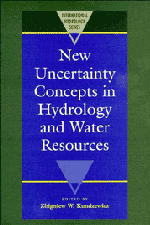Book contents
- Frontmatter
- Contents
- List of Authors
- Preface
- I INTRODUCTION
- II FACETS OF UNCERTAINTY
- III NOVEL APPROACHES TO UNCERTAINTY: FRACTALS, FUZZY SETS AND PATTERN RECOGNITION, NON-PARAMETRIC METHODS
- 1 Dispersion in stratified soils with fractal permeability distribution
- 2 Multifractals and rain
- 3 Is rain fractal?
- 4 Multifractal structure of rainfall occurrence in West Africa
- 5 Analysis of high-resolution rainfall data
- 6 Application of fuzzy theory to snowmelt runoff
- 7 On the value of fuzzy concepts in hydrology and water resources management
- 8 Application of neural network in groundwater remediation under conditions of uncertainty
- 9 Application of pattern recognition to rainfall–runoff analysis
- 10 Nonparametric estimation of multivariate density and nonparametric regression
- 11 Nonparametric approach to design flood estimation with pre-gauging data and information
- IV RANDOM FIELDS
- V TIME SERIES AND STOCHASTIC PROCESSES
- VI RISK, RELIABILITY AND RELATED CRITERIA
7 - On the value of fuzzy concepts in hydrology and water resources management
Published online by Cambridge University Press: 07 May 2010
- Frontmatter
- Contents
- List of Authors
- Preface
- I INTRODUCTION
- II FACETS OF UNCERTAINTY
- III NOVEL APPROACHES TO UNCERTAINTY: FRACTALS, FUZZY SETS AND PATTERN RECOGNITION, NON-PARAMETRIC METHODS
- 1 Dispersion in stratified soils with fractal permeability distribution
- 2 Multifractals and rain
- 3 Is rain fractal?
- 4 Multifractal structure of rainfall occurrence in West Africa
- 5 Analysis of high-resolution rainfall data
- 6 Application of fuzzy theory to snowmelt runoff
- 7 On the value of fuzzy concepts in hydrology and water resources management
- 8 Application of neural network in groundwater remediation under conditions of uncertainty
- 9 Application of pattern recognition to rainfall–runoff analysis
- 10 Nonparametric estimation of multivariate density and nonparametric regression
- 11 Nonparametric approach to design flood estimation with pre-gauging data and information
- IV RANDOM FIELDS
- V TIME SERIES AND STOCHASTIC PROCESSES
- VI RISK, RELIABILITY AND RELATED CRITERIA
Summary
ABSTRACT Evaluation of the applicability of the fuzzy sets theory in the area of hydrology and water resources management is attempted. In this respect, the determination of the membership functions and the interpretation of the results of operations on these functions are of crucial significance. Using water resources allocation problems as an example, the advantages of fuzzy set approaches vis a vis other techniques are demonstrated and discussed. Although the advantages of fuzzy approaches in the decision-making contexts are not always straightforward, these approaches seem to be very attractive in the various diagnostic and classification problems in hydrology and water resources management as well. This is illustrated by the application of some elements of fuzzy sets theory within the framework of a decision support system for a choice of an analog catchment.
INTRODUCTION
Water resources systems include a number of physical, economical, social, and environmental factors that must be considered in making choices among alternative options for resource use and control. The development and application of planning, management, and policy-oriented models for helping water resources managers have been taking place for several decades throughout the world. Most of them deal in one or another way with the uncertainty issue – uncertainty due to the random character of natural processes governing water supply (precipitation, streamflow, etc.), uncertainty concerning management objectives and evaluation criteria, and uncertainty about the future embedded above all in future demand projections.
- Type
- Chapter
- Information
- New Uncertainty Concepts in Hydrology and Water Resources , pp. 126 - 132Publisher: Cambridge University PressPrint publication year: 1995
- 3
- Cited by



